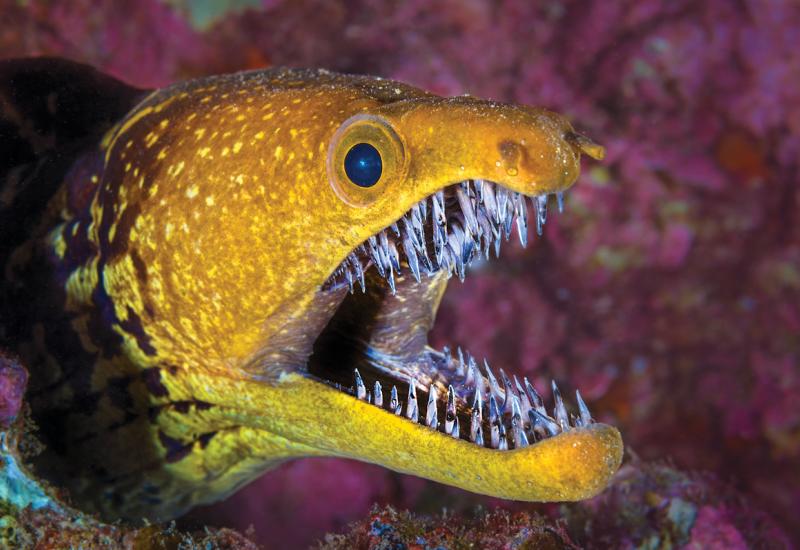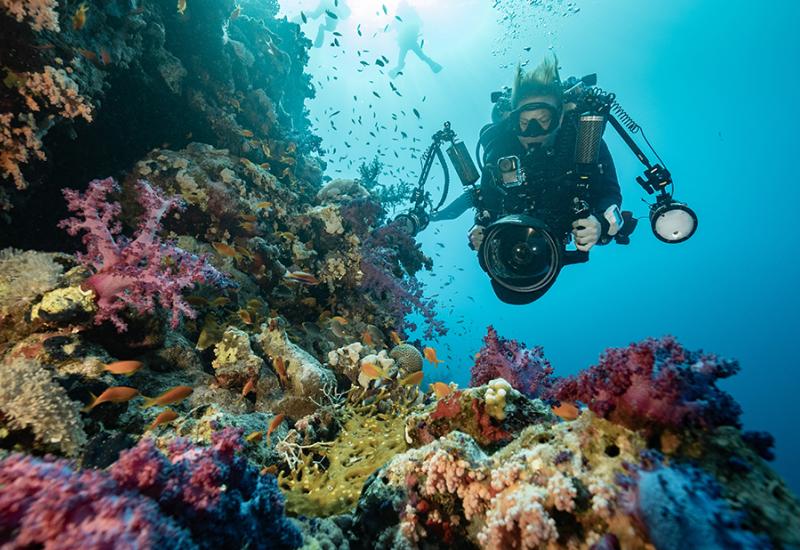How to Take Flawless Photos of Sweetlips

Alex MustardGear Nikon D850 with 28-70mm lens and Nauticam WACP-1
Settings f/13; 1/100; ISO 400
Simultaneously goofy and handsome, sweetlips are large reef fish that sport the bright colors and eye-catching markings normally associated with smaller tropical fish. They often gather in groups, and if you approach carefully, they will hold formation. Their large eyes and pout give them highly characterful faces. While adults are sociable, big and dozy, the youngsters look completely different, are invariably solitary and perform a hyperactive dance.
Juvenile sweetlips are usually found in the shallows or on muck sites. Their main defense against predators is a gyrating dance, which makes for great macro images, especially using long exposures to show the movement. For this shot, combine a slow exposure (slower than onetenth of a second) with a burst of flash. First, select a small aperture and low ISO to correctly expose the ambient light during a long exposure while freezing the subject with the flash. Use first curtain sync for the flash to be sure the subject is in focus and frozen. A snooted strobe is ideal to light just the fish and not the surroundings. Frame it against open water for a dark background.
Related Reading: Names for Groups of Marine Life That Are Sure to Make You Laugh
Groups of adult sweetlips are particularly photogenic when their colorful bodies are neatly arranged. For these shots, how you approach the group is crucial—strike a balance between getting close enough for a frame-filling composition, whilenot disrupting the formation. A wide-angle zoom is the right lens for this job. Sweetlips tend to constantly jostle for position in the pack and look untidy in the process! This means patience is important when shooting schools because one messy fish can ruin that perfect picture, and you will often have to wait for the best shot. The alternative is to single out an adult with your macro lens for a portrait. I use telephoto lighting for these shots, pushing my strobes considerably further forward than my lens to reduce the light path, minimize backscatter and get more light on the subject.
Related Reading: Expert Alex Mustard Shares His Secrets on How to Photograph Dolphins in the Wild
Although sweetlips will happily face directly toward the camera, their eyes are on the sides of their head, so while you can easily get both eyes in a photo, you won’t get strong double eye contact. Instead, think of sweetlips as a “one eye subject” fish, where your priority is to focus on just one eye with great eye contact rather than two with a weak connection.

Alex MustardGear Nikon D7100 with 105mm
Settings f/8; 1/100; ISO 200
Behind the Shot
1 This group of oriental sweetlips in Laamu Atoll, in the Maldives, showcases formation. It is easy to mess up these formations by moving too close. I avoid this by using a zoom lens to give the school space. Here I used the 28-70mm with the Nauticam WACP-1 lens, zoomed in to 48mm to allow me to fill the frame with a great formation. Avoid dropping below schools of sweetlips because their white undersides are their least attractive side. Eye level or slightly above works best.
2 Sweetlips must be constantly itchy because few fish seem to spend as much time at cleaning stations. Use a long focallength lens for these shots (here, a 105mm on a crop sensor camera), as it keeps the subjects more relaxed, giving better poses.
My first priority in these images is to find a good angle on the sweetlips so that the picture already works without the wrasse. A side-on profile often works best, giving great eye contact and showing off the patterns. Then I will wait for the wrasse to swim into a good position. An excellent shot is when the sweetlips opens its mouth and invites the wrasse completely inside. I like to shoot when the wrasse’s face reappears.
Where to See Them
Sweetlips gather on reefs of the tropical Indo-Pacific. There are about 30 species, 10 of which are especially photogenic. Some of the best locations to photograph them are the Ribbon Reefs of the Great Barrier Reef, the Dampier Strait in Raja Ampat, and Kandus and Thilas in the Maldives.










